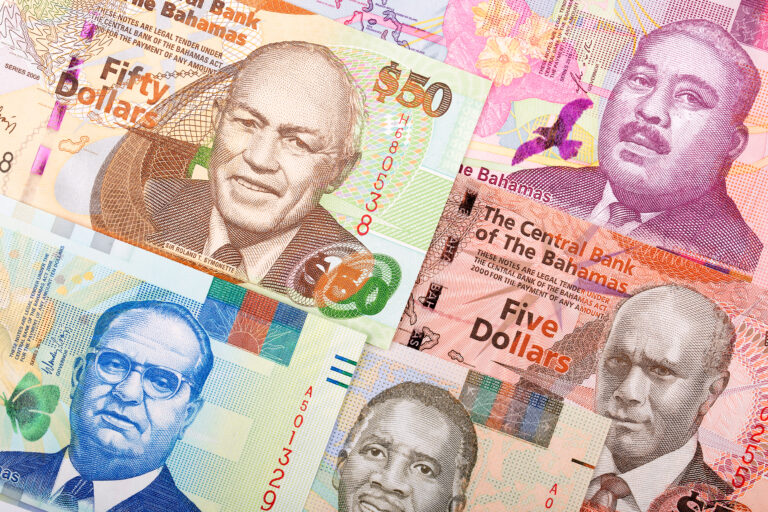Whether you’re planning a holiday in the Bahamas or sending money to friends and family there, it’s useful to understand the local currency. The Bahamian dollar (BSD), often written as B$, is the national currency of the Bahamas. Issued by the Central Bank of the Bahamas, it is pegged one-to-one with the U.S. dollar (USD), making transactions straightforward for visitors.
Here’s a detailed guide to the Bahamian dollar, its history, denominations, and key facts.
Coin and Banknote Denominations
The Bahamian dollar is subdivided into 100 cents and is available in the following denominations:
Coins
- 1¢: Three starfish
- 5¢: Pineapple
- 10¢: Two bonefish (scalloped edge)
- 15¢: Three hibiscus flowers (square coin)
- 25¢: Native sloop (serrated edge)
- 50¢: Blue marlin
- B$1: Conch shell
- B$2: Two flamingos
Banknotes
- B$0.50, B$1, B$3, B$5, B$10, B$20, B$50, B$100
The vibrant banknotes feature important Bahamian figures such as Sir Lynden O. Pindling (B$1) and Sir Stafford Sands (B$10). In 2016, the Central Bank of the Bahamas released a new CRISP series, incorporating advanced security features to combat counterfeiting.
Five Facts About Bahamian Currency
1. Bahamian Banknotes Honour Key Figures
Modern Bahamian banknotes celebrate figures like Sir Milo B. Butler, the first Bahamian Governor-General (B$20), and Arthur Dion Hanna, a former Governor-General (B$100). Queen Elizabeth II also appears on certain denominations, reflecting the Bahamas’ membership in the Commonwealth.
2. Coins Feature Unique Designs
Each coin highlights Bahamian flora, fauna, or cultural elements, such as the iconic conch shell on the B$1 coin or the native sloop on the 25¢ coin.
3. The Bahamas Is a Digital Currency Pioneer
In 2020, the Bahamas introduced the “Sand Dollar,” the world’s first legal digital currency. It has the same value as the Bahamian dollar but offers a secure and convenient digital alternative.
4. The U.S. Dollar Is Widely Accepted
Visitors can pay using both BSD and USD interchangeably, with a fixed exchange rate of 1 BSD = 1 USD. This simplifies transactions for tourists, especially Americans, who don’t need to exchange money.
5. CRISP Technology Prevents Counterfeiting
The CRISP series includes features such as watermarks, latent images, and phosphorescent designs, making Bahamian banknotes resistant to forgery.
The History of the Bahamian Dollar
Before the Bahamian Dollar
The Bahamas used the British pound until 1966, when it switched to the Bahamian dollar. Initially, coins were the only form of currency, followed by the introduction of banknotes in 1968.
Modern Changes
The Bahamian dollar has undergone updates to improve its security and design, with the most recent series released in 2016.
Using Money in the Bahamas
Payment Methods
While credit cards like Visa and Mastercard are widely accepted, cash remains essential for small businesses and markets. Carry small denominations for convenience.
Exchange Rates
The Bahamian dollar’s fixed exchange rate with the U.S. dollar eliminates the need to monitor rate fluctuations. For visitors from other countries, such as the UK, exchanging GBP to BSD is straightforward, but converting to USD beforehand may offer added flexibility.
Sending Money to the Bahamas
If you’re sending money to the Bahamas, modern transfer services like Remitly offer secure, fast, and cost-effective options. Transfers can be sent directly to bank accounts or for cash pickup at numerous locations across the islands.
